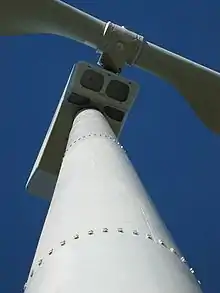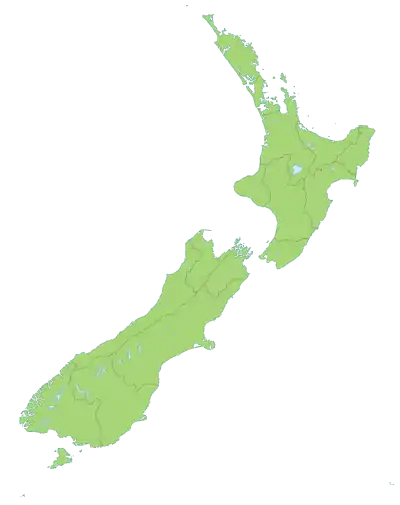Wind power in New Zealand
Wind power constitutes a small but growing proportion of New Zealand's electricity. As of December 2020, wind power accounts for 690 MW of installed capacity and over 5 percent of electricity generated in the country.[1]

New Zealand has abundant wind resources. The country is in the path of the Roaring Forties, strong and constant westerly winds, and the funneling effect of Cook Strait and the Manawatu Gorge increase the resource's potential. Over three-quarters (512 MW) of the country's wind generation is installed within a 150 km (93 mi) radius of Palmerston North, with some turbines in the area having a capacity factor of over 50 percent.[2]
Generation capacity and expansion

As of December 2020, New Zealand had an installed wind generation capacity of 690 MW.[1] In the 2020 calendar year, wind power produced 2,282 GWh of electricity, 5.5 percent of the country's electricity generation that year.[1]
A further 2,500 MW of wind farms have received resource consent.[3]
The New Zealand Wind Energy Association predicts that wind could reach 20 percent of New Zealand's annual generation by 2035.[4]
Wind potential

New Zealand has outstanding wind resources, due to its position astride the Roaring Forties, resulting in nearly continuous strong westerly winds over many locations, unimpeded by other nearby landmasses at similar latitude.[5] One study found that using 1% of total available land for wind farms would produce approximately 100,000 gigawatt hours (GWh) per year.[6] This is roughly two times the annual electricity consumption of New Zealand. Nearly continuous, however, does not mean continuous: high-pressure weather systems, for instance, sometimes cover the entire country, resulting in no significant winds anywhere, and dispatchable sources like hydro and gas must take over.
The strength and consistency of New Zealand winds means the nationwide capacity factor is high compared to other countries, averaging between 30 and 35 percent, with some individual turbines recording capacity factors above 50 percent.
Public opinion
Wind farms and turbines generate a wide range of opinions from outright opposition to widespread acceptance. Opposition is due to noise, aesthetics and ecological factors.
Coping with intermittency
Wind farms partner well with hydro plants on the same grid to create combined power plants, because hydro plants can be uprated with extra turbine units to provide highly dispatchable peak generating capacity above the average flows of their rivers, at lower cost than other peak power options.[7] During periods of high wind and low electricity demand, a hydro plant can reduce its output to accumulate water in its reservoir, whilst wind power handles a higher share of the grid load. Then during periods of low wind, the hydro plant can raise its output temporarily, drawing down its reservoir a bit. Given New Zealand's large proportion of hydroelectric generating capacity, it is better-positioned than most nations to uprate its generating stations and grid to handle intermittent power sources such as wind and solar. The available virtual energy storage represented by hydro plants can be one of the main factors limiting the maximum amount of wind and solar power that a grid can accommodate. Further increases in intermittent power source development may require construction of pumped-storage hydroelectricity and implementation of energy demand management techniques.
List of operating wind farms
Only wind turbines and farms over 5 MW generating capacity are listed. Individual demonstration and prototype wind turbines have been installed at Southbridge in Canterbury,[8] Gebbies Pass near Christchurch and Brooklyn in Wellington. Many small windmills serve as windpumps on New Zealand farms.
| Name | Commissioned | Operator | Number of turbines | Installed capacity (MW) | Annual average generation (GWh)[9] | Coordinates |
|---|---|---|---|---|---|---|
| Flat Hill[10] | September 2015[11] | Pioneer Generation | 8 | 6.8 | 46°35′S 168°17′E | |
| Hau Nui | 1997 | Genesis Energy | 15 | 8.65 | 22 | 41°22′S 175°29′E |
| Mahinerangi | March 2011 | Mercury Energy | 12 | 36 | 105 | 45°45′S 169°54′E |
| Mill Creek | May 2014[12] | Meridian Energy | 26 | 59.8 | 41°13′S 174°44′E | |
| Mt Stuart[13] | December 2011 | Pioneer Generation | 9 | 7.65 | 46°4′S 169°46′E | |
| Tararua | 1999–2007 | Mercury Energy | 134 | 161 | 650 | 40°21′S 175°47′E |
| Te Apiti | 2004 | Meridian Energy | 55 | 91 | 258 | 40°18′S 175°48′E |
| Te Rere Hau | 2006–11 | NZ Windfarms | 97 | 48.5 | 40°23′S 175°43′E | |
| Te Uku | 2011 | WEL Networks / Meridian Energy | 28 | 64.4 | 37°53′S 174°58′E | |
| Turitea[14] | 2021 | Mercury Energy | 33 | 119 | 40°26′28″S 175°40′17″E | |
| Waipipi | November 2020[15] | Mercury Energy | 31 | 133.3 | 455 | 39°47′S 174°33′E |
| Project West Wind | 2009 | Meridian Energy | 62 | 142.6 | 550 | 41°17′S 174°40′E |
| White Hill | 2007 | Meridian Energy | 29 | 58 | 200 | 45°45′S 168°16′E |
Meridian Energy also operates a 1 MW wind farm on Ross Island, Antarctica. It is not included in the above list as it does not contribute electricity to the New Zealand national electricity network.[16][17]
Proposed and under construction
Abandoned
| Name | Operator | Projected capacity (MW) | Comments | Coordinates |
|---|---|---|---|---|
| Hauauru ma raki | Contact Energy | 540 | Abandoned[29] | 37°34′4″S 174°48′18″E |
| Project Hayes | Meridian Energy | 630 | Abandoned in January 2012 | 45°30′39″S 169°53′3″E |
| Long Gully | Windflow Technology | 12.5 | Consents lapsed | 41°19′36″S 174°43′4″E |
| Maungatua Wind Farm[30][31] | Windpower Maungatua | 25 | Abandoned[32] | |
| Motorimu Wind Farm[33] | Motorimu Wind Farm | 108 | Consents surrendered[34] | |
| Puketiro | RES NZ | 150 | No consents, apparently abandoned | 41°06′S 174°54′E |
| Taharoa Wind Farm[35] | Taharoa C | 100 | Consents lapsed[36] | |
| Waitahora | Contact Energy | 177 | Consents lapsed, abandoned[37] | 40°21′44″S 176°10′24″E |
See also
| Wikimedia Commons has media related to Wind power in New Zealand. |
- Energy in New Zealand
- Renewable energy commercialization
- Solar power in New Zealand
- Ocean power in New Zealand
- Geothermal power in New Zealand
- Biofuel in New Zealand
- Hydroelectric power in New Zealand
- Solar hot water in New Zealand
- Electricity sector in New Zealand
- List of power stations in New Zealand
- Renewable energy in New Zealand
- Renewable energy by country
References
- "Energy in New Zealand 2021". MBIE. August 2021. Retrieved 31 December 2021.
- Bradley, Grant Bradley, Grant (7 June 2011). "Wellington winds too windy for wind farm". The New Zealand Herald. ISSN 1170-0777. Retrieved 25 March 2018.
- "New Zealand's wind farms". New Zealand Wind Energy Association. Retrieved 5 June 2019.
- "Wind Energy to be 20% of NZ Generation by 2035". New Zealand Wind Energy Association. Retrieved 5 June 2019.
- "New Zealand wind resource". New Zealand Wind Energy Association. 10 January 2008. Archived from the original on 10 January 2008. Retrieved 8 August 2008.
- "New Zealand's Wind Resource". New Zealand Wind Energy Association. Archived from the original on 20 March 2007. Retrieved 8 March 2008.
- "Hydroelectric Power" (PDF). United States Bureau of Reclamation. Retrieved 13 October 2008.
- New Zealand Wind Energy Association – Southbridge Wind Turbine Archived 4 July 2008 at the Wayback Machine
- "List of Generating Stations". New Zealand Electricity Authority. November 2010. Archived from the original on 24 July 2011. Retrieved 25 January 2011.
- "Flat Hill". New Zealand Wind Energy Association. Retrieved 14 August 2015.
- MCleod, Hannah (1 September 2015). "New Bluff wind farm can power 2500 homes". stuff.co.nz. Retrieved 20 October 2017.
- "Meridian's new windfarm open". Dominion-Post. 8 January 2015. Retrieved 14 August 2015.
- "Proposed Mt Stuart Windfarm Information". Clutha District Council. Archived from the original on 1 March 2009. Retrieved 6 February 2009.
- Cook, Alexa (8 May 2021). "First stage of Mercury's Turitea Wind Farm to be switched on in October after year-long delay". Newshub. Retrieved 9 June 2021.
- "Wind power blows in to South Taranaki". Stuff. 17 November 2020. Retrieved 20 January 2021.
- "Ross Island wind farm". New Zealand Wind Energy Association. Archived from the original on 17 November 2013. Retrieved 15 February 2009.
- "McCully opens Antarctic wind farm". The New Zealand Herald. 16 January 2010. Retrieved 16 January 2010.
- Chug, Kiran (2 April 2011). "Planned wind farm would be biggest". Stuff. Fairfax. Retrieved 2 April 2011.
- Lawrence Gullery (28 September 2018). "Wind farm's towering turbines worry nearby Te Aroha residents". Stuff. Retrieved 17 June 2021.
- Peter de Graaf (20 May 2021). "Wind farm planned north of Dargaville could power 25,000 homes". New Zealand Herald. Retrieved 17 June 2021.
- Robyn Bristow (22 April 2021). "Construction of South Island's largest wind farm to start soon in Nth Canterbury". Otago Daily Times. Retrieved 27 June 2021.
- "Central Wind project". Meridian Energy. Retrieved 15 February 2021.
- "Windfarm investigation blows on". Northern News. 9 October 2007. Retrieved 3 December 2011.
- Rachel Young (18 April 2013). "31 wind turbines for Hurunui". Stuff. Retrieved 27 June 2021.
- Janine Rankin (5 June 2013). "Puketoi wind farm gets final go-ahead". Stuff. Retrieved 27 June 2021.
- Mike Barrington (30 December 2008). "Giant wind farm plan". Northern Advocate. Retrieved 31 December 2008.
- Alana Dixon (15 April 2011). "Slopedown wind farm not a priority: Genesis". Stuff. Retrieved 27 June 2021.
- Cook, Alexa (8 May 2021). "First stage of Mercury's Turitea Wind Farm to be switched on in October after year-long delay". Newshub. Retrieved 9 June 2021.
- "Windfarm backtrack has heavy cost". Stuff. 21 August 2013. Retrieved 27 June 2021.
- "Mt Maungatua wind-farm proposal grows 25%". Otago Daily Times. 15 July 2008.
- 6 month report to 31 December 2008, NZ Windfarms Limited, 2 March 2009. Quote: "the WindPower Maungatua wind farm ... is now unlikely to proceed in the near future, if at all".
- "Wind farm development abandoned". Otago Daily Times. 29 August 2009.
- "Notice of Decision" (PDF). Joint Hearings Commissioners. Retrieved 14 February 2009.
- Miller, Grant (25 August 2009). "Wind farm idea off table as liquidators surrender consent". The Manawatu Standard.
- NZPA (2 February 2006). "Three wind farms planned for Waikato". The New Zealand Herald. Retrieved 22 March 2011.
- "Taharoa". New Zealand Wind Energy Association. Retrieved 27 June 2021.
- McKay, Christine (31 August 2016). "Surprise at windfarm consent expiry". The New Zealand Herald. Retrieved 15 February 2021.
External links
- New Zealand Wind Energy Association
- "Carbon neutral wind energy can close off nuclear option" (PDF). New Zealand Wind Energy Association. 13 September 2007. Archived from the original (PDF) on 27 August 2008. Retrieved 13 September 2008.